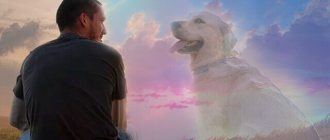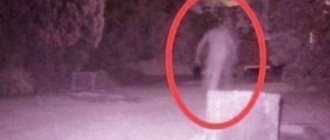Where do animals go after death: opinions from different sides. What is considered to be the soul in our high-tech life? Character traits, worldview, emotions, energy field, or a substance separate from the mortal body? Are all living creatures endowed with a soul or only humans? Is the soul immortal and what happens to it after the end of its earthly existence?
A believer considers the soul to be a subtle matter that connects earthly existence with eternity. An atheist interprets the concept of soul as personal individuality, consciousness and acquired experience. Whether animals have a soul and where it goes after physical death remains an unproven theory.
Scientific interpretation - where animals go after death
Scientists of all times have proven the presence of a mental component in humans, with the help of which the perception of the surrounding reality occurs. From the ancient Greek language the word “psyche” is translated as “soul”. Judging by this, we can assume that all earthly creatures capable of expressing emotions have a soul, including our smaller brothers. Scientists have put forward a more specific hypothesis: the soul is electromagnetic impulses, a special energy that, after the death of the body, returns to the general energy field of our planet as part of the entire Universe.
Transforming into a different energy form, the soul nourishes all living things, being held by the powerful electromagnetic field of the Earth. Thus, science claims that the soul of animals does not move to a new world, but remains close to people, existing in a different capacity.
When did animals become mortal?
On this issue, there is an opinion that mortality is inherent in animals from the moment of creation. The sources for this opinion are, on the one hand, an understanding of the fundamental difference between the souls of people and animals, and on the other, an attempt to give logical integrity to the connection between natural scientific discoveries and Divine Revelation, an attempt to rationally link scientific data and the biblical text. In general, arguing that animals were created by the Creator to be initially mortal, supporters of this point of view differ only in the forms of adapting their opinion to the narrative of Holy Scripture. Thus, according to one point of view, the death of animals and the death of humans are two different phenomena that have only a common name. Supporters of this point of view argue that: “the departure of animals is not death, it is not something similar to the departure of humans. If we say “the death of Socrates,” then we do not have the right to use the same word in the statement “the death of a dog.” The death of a star is a metaphor. The same metaphor can be said about the “death” of an atom or a stool. Animals disappeared from existence and ceased to exist in the world before humans. But this is not death. And therefore, in a theological and philosophical sense, it is impossible to talk about the phenomenon of death in the non-human world”[1]. Another “justification” for animal mortality is that animals are not considered creatures designed to last forever. “Initially it was believed that animals do not have an eternal soul”[2]. It is believed that only man was created by God for eternal life, and for all other creatures, including animals, the process of death and decomposition is natural.
According to another view, animals outside Eden and animals supposedly in Eden had different existences. They say that animals outside of Eden are animals familiar to us, which evolved, appeared and died in the usual way. “It is quite possible that outside the Edenic fence all the laws of the struggle for existence already existed,”[3] the supporters of this version suggest. “Adam was expelled from the Garden of Eden, and he had to live on this earth... Imagine how they yearned for the Garden of Eden when they began to live on this damned earth!”[4]. Those. the world outside Eden, according to supporters of the version, was the same world that is now accessible to us in sensations. Exceptional conditions existed only inside Eden.
As we see, when fixing the difference in the nature of humans and animals, what eludes supporters of the theory of natural mortality of animals is that “at creation everything was good and green, that is, pure, beautiful and harmless”[5]. “In a similar way, the Venerable Gregory of Sinaite wrote: “The now flowing creation was not originally created corruptible, but later fell into corruption, obeying vanity, according to the scripture, not willingly, but not willingly, for Him who obeyed it, in the hope of renewal of Adam, who was subject to corruption (Rom. 8.20) . He who renewed Adam and sanctified him also renewed the creation, but did not yet deliver them from corruption” [6]. If we are talking about who was created mortal and who was immortal, then, for example, according to the opinion “saint. Athanasius, and man himself was created mortal, for that which received its beginning through change can also disappear. But it doesn’t follow from this that Adam had to die, even if he had not sinned (compare rules 123 and 124 of the Council of Carthage)? Likewise, animals were created with the possibility of death, and with the possibility of fighting for existence, and with organs that later began to be used for predation, but before sin, lions ate green grass (Genesis 1, 29-30)”[7].
Patristic thought indeed singles out the biblical Eden as a special place of Adam's abode, but does not at all deduce from this fact the presence of death or destruction outside the boundaries of Eden. “We are going to a place of heaven”[8]. “Not the whole earth was paradise, but paradise was, as it were, its capital”[9]. “Man lived on earth like some kind of angel - he was in the body, but had no bodily needs; like a king, adorned with scarlet and a diadem and clothed in purple, he freely enjoyed the heavenly dwelling, having abundance in everything.”[10] “So, didn’t He then give one thing, and now want to give another? I don’t think so”[11].
The trouble with supporters of the original mortality of animals is that they approach the adaptation to the biblical text of the processes of birth, life and death, which we objectively observe in the animal world around us, from the position of materialism, building their theories on the basis of the perception of matter as “an objective reality given to us in sensation”[12]. But guided solely by sensations of objective reality, we fall into error even in seemingly obvious things. The experimentally confirmed fact that time at the top of, say, a water tower moves at a different speed than time at the foot of the tower is puzzling from the standpoint of objective reality. “If one twin lives on top of a mountain and the other by the sea, the first will age faster than the second. And if they happen to meet again, one of them will be older.”[13] If we objectively not only do not know, do not understand, do not feel the really ongoing processes in the existing material world, then projecting obviously false sensations into a world that is not even accessible to us in sensations, a world that is cosmologically not matter-centric, but theocentric, is absurd. “Now the earth appears to our eyes in a completely different form. We do not know her state in holy virginity; we know her in a state of corruption and damnation, we know her already doomed to be burned[14]; she was created for eternity”[15]. The world in which Adam lived before the Fall is cosmologically different in relation to the world “available to us in sensations.” Understanding this fact makes the problem of “Adam and the dinosaurs”[16] as absurd as, for example, the problem of “God and the stone”[17]. The absurdity lies in the use of means to resolve the issues raised that are absolutely foreign and alien to the sphere of the issues themselves.
We are dealing with a world distorted by sin. A person who was born and spent his whole life in ruins will be sure that the whole world lies in ruins. We can pose the question regarding the first problem cited as an example: “Who came first, Adam and Eve or the dinosaurs, in the space-time system of a world distorted by sin?” But we must understand that any answer we give to this question will not reflect the real picture of the world before the Fall. Therefore, the controversy surrounding such issues as the length of the days of creation [18] is reminiscent of a dispute between ice cream connoisseurs who have never eaten it.
We need to find out whether death is natural for animals, whether death is inherent in the nature of animals. Can we say that before the Fall, only man could live indefinitely, and animals, fish and birds were born and died in accordance with natural biological laws established by the Creator?
First, let's look at what death is in general. What exactly are we talking about when we mention death? Patristic thought distinguishes two types of death in humans - mental and physical. “You need to know that just as a person has a body and a soul, he has two deaths: one is the death of the soul, the other is the death of the body; as well as two immortalities - mental and physical, although both are in one person, for soul and body are one person. So Adam died in soul immediately as soon as he tasted it, and then, nine hundred and thirty years later, he died in body. For just as the death of the body is the separation of the soul from it, so the death of the soul is the separation from it of the Holy Spirit, with whom God, who created him, was pleased to overshadow man.”[19] From the point of view of trichotomists, a person also has two deaths, since it is absurd to assume the death of the immortal spirit invested by the Divine breath in a person. Thanks to the spirit that inspires the human soul, a person, having been born, has eternal existence, be it eternal life or eternal torment after death. The “rational soul” for dichotomists “is distinguished from the animate body, in which one can distinguish between body and living soul” [20] and in fact represents a spiritualized soul.
So, firstly, death in general is the destruction of integrity, division into component parts. Death is the destruction of nature (essence); separation into separate natures is death. Secondly, there is bodily death - this is the separation of the soul from the body, the destruction of the essence of the individual, in which the soul and body constitute one nature. It is precisely this process of death that we observe both in humans and in dumb people. Thirdly, a person has spiritual death - this is the destruction of communion with God, the deprivation of the grace of the Holy Spirit. The last death is also called spiritual[21]. Such death is unique to humans.
Let us also remember that death was not created by God. “God did not create death and does not rejoice in the destruction of the living, for He created everything for existence, and everything in the world is saving, and there is no harmful poison, and there is no kingdom of hell on earth” (Wis. Sol. 1:13,14). God only warns a person about the possible dire consequences of disobedience: “You must not eat from the tree of the knowledge of good and evil, for in the day that you eat from it you will surely die” (Gen. 2:17). The source of death in the world, Holy Scripture names only the sin of man, the fall of the forefather Adam. “Just as through one man sin entered into the world, and death through sin, so death spread to all men, because all sinned” (Rom. 5:12).
If the death that struck the whole world is a consequence of Adam’s sin, then, no matter how surprising it may be for us, we must admit that the animals, if Adam had not sinned, would also live forever. Since death is destruction, then before the appearance of death the nature of animals was not subject to destruction, and, therefore, the soul was not separated from the body. Having made this conclusion, we must also make the following – animals potentially have the possibility of eternal life. This possibility was realized while man lived in symphony with the Divine Will. In order to stop attempts to absolutely idealize the life of animals before the Fall of man, we note that the life of animals initially passed in accordance with basic instincts, and not in the contemplation of the Divine. After the Fall, there is “what we received from the skin of the dumb—carnal mixture, conception, birth, uncleanness, breasts, food, eruption, gradual coming to perfect age, maturity of age”[22].
And one more conclusion needs to be made. Since man, living sinlessly, allowed the animal world to exist without death, and the death of man entailed the appearance of death in animals, it means that there is a closer connection between man and animals than simply the intersection of interests of biological species.
Psychics' opinion - where animals go after death
People with special knowledge and supernatural abilities can look beyond the looking glass. Having the opportunity to communicate with the world of the dead, clairvoyants are inclined to assert that the life of animals continues after the death of the bodily shell. Ceasing its earthly existence, any animal can make the transition to our world and back an infinite number of times. The purpose for which deceased pets make this journey depends on how the person treated him during his life. If the owner loved his four-legged household member, then the soul of the animal will completely help and protect him, and if there was no affection, it will do dirty tricks and even take revenge.
Pet perfumes
The spirits of pets in the form of some signs can visit not only a righteous believer, but also a convinced skeptic. That's why we need to talk about it. And the signs will appear in the feeling of the presence of a cat or dog in the house, in a real vision of a fluffy, touching his fur, inhaling the smell of his food...
In the film “All Dogs Go to Heaven,” the main idea is the understanding that being “on the other side” of life, a pet will definitely come to the one it loved during life.
Breakfast porridge, dental floss: Changes in daily routine reduce risk of dementia
Watering with cold water and more: how to save trees from return frosts
NASA has come up with “eternal” bicycle tires that don’t need air
There are several common types of visits your beloved pet may receive. Some of them are documented, others were told by mediums, others are part of the family history of some people.
Orthodox vision - where animals go after death
The Holy Scriptures do not directly say anything about the presence of souls in animal creatures. Man received his soul from God. She is immortal. And the soul of animals, according to the Orthodox Church, is in their blood and therefore is destroyed with the death of a living creature. The Bible says that Heaven is reserved only for sinless human souls.
The Church claims that the soul of a person and an animal are completely different matter and exist separately. The animal soul does not move anywhere, but only dissolves in the common energy resource, feeding other lives. Some clergymen mentioned in the chronicles that man unites the life of plants and animals, and that the soul of the latter after death ascends to “a single common soul.”
In the Orthodox world, there is an opinion that as a result of long-term communication with a person, the “destroyed” soul of an animal is enriched, closely intertwined with the human. If a four-legged creature was homeless, then its soul after death is reunited with the “single soul”.
Looking at the topic of Orthodoxy’s attitude to life after the death of animals from the other side, it can be noted that animals and birds are depicted next to many saints. The description of Heavenly Paradise also includes a mention of animals, therefore, the souls of animals are still present in heaven. Taking into account all the facts, we can say that the end has not yet been reached in the Christian discussion about the immortality of animal souls.
Is it possible to love animals more than people?
So, the fate of animals in the Future Life is a mystery to us. All living things are God's creation, so animals can and should be loved. However, it is very important that love for pets does not interfere with the fulfillment of the main commandments - love for God and neighbor. In the 4th volume of the “Words” of St. Paisius the Holy Mountain, you can find the elder’s phrase that in our time, many spouses do not rely on God and, for the sake of their own comfort, refuse to give birth to children. Instead, couples have pets. According to the Monk Paisius, such people forget that one of the goals of married life is the birth of children and raising them in the Christian spirit.
Another Athonite elder, the Monk Silouan, said: “One should not have partiality for animals, but should only have a heart that has mercy on every creature” (“Elder Silouan”).
Human faith is in the journey of the soul after the death of an animal
The owner and the beloved pet are united by an invisible leash of love. Therefore, after the death of a beloved animal, its soul will remain with the grieving owner for a long time, continuing to protect not from visible threats, but from the hidden influence of negative forces.
Humanity is inclined to believe that a sweet creature after death did not dissolve in the depths of the universe, but remained an integral soul, a meeting with which in due time will happen in heaven. After all, there is not a drop of sin in the soul of an animal, but there is only great love for man. So, walking through the Garden of Eden in the company of your beloved tailed pet is quite possible.
Paradise for cute fluffies
Paradise for them is similar to human heaven - a place where cats, dogs, hamsters want to be... They want to be with their beloved owner or other animals with whom they were friends while still alive.
That is why, after the furries pass away, they want to once again meet the one they loved then and continue to love now.
Another sign of the presence of a deceased animal is that you can feel its presence simply by sitting or lying on a bed or in a chair. It seems as if something invisible is curled up or stretched out on a pillow near your face.
This is more typical for cat owners. A typical style of these proud animals and a sign that the cat has come for a visit is to feel it lay down on your lap or at your feet. Most often, the owner feels it precisely at the moment of rest.
Corrosiveness: how to properly check the quality of autogas
Kirill Zaitsev spoke about perfectionism, bloody calluses and personal life
You can also have sweets: a nutritionist said that it’s not harmful to eat sweets in the morning
With your peripheral vision you can detect the presence of a dead fluffy. This can mean two things: either the person received the gift from one of his great-grandmothers, or the pet actually came to visit.
Endangered Species Theory
According to the Order of the Rose and Cross, a secret mystical and theological society founded by Christian Rosenkreutzen in Germany during the late Middle Ages, endangered species of some animals are constantly reborn in the form of others. Each individual makes a great evolutionary contribution to the development of a certain class of animals.
Repeated rebirth allows you to improve the skills and appearance of the animal world. Rosenkreutzen believed that extinct animals did not disappear from the face of the earth. Their souls were able to rise to a higher evolutionary level, so we can only be happy for them.
Animals and people develop amazing relationships, full of care and love. Every owner wants their pet to live next to them as long as possible. But if one is destined to part with a pet due to death, a person prefers to believe that the animal’s soul will always be with him or will find peace in the rainbow or in heaven.
How do attitudes toward animals change in the New Testament?
The relevance of the Old Testament division into clean and unclean animals, edible and those that cannot even be touched for fear of becoming unclean, disappears in the New Testament. The new ethics received its symbolic expression in a vision of the Apostle Peter, who, getting hungry while praying, saw a huge vessel descending from heaven, full of both clean and unclean animals and birds. In response to Peter’s refusal to eat unclean creatures, a voice was heard from heaven: what God has cleansed, do not consider unclean (Acts 10:15 ). The vision also had one more meaning: the Lord made Peter understand that the preaching of the Gospel was addressed not only to the chosen people, but also to the pagans, whom the Jews had previously abhorred. This idea was later expressed by the Apostle Paul, who said that in the Church there is neither Greek nor Jew, circumcision nor uncircumcision, barbarian, Scythian, slave, free, but Christ is all and in all (Col. 3:11 ).
In the New Testament era, the previous utilitarian attitude towards animals changed. Saint Basil the Great already defined their purpose as follows: “One (animal - editor’s note) was created to serve man, and the other so that he could contemplate the wonders of creation, while the other is scary for us, in order to admonish our negligence.” In the history of the Church we see many examples of the merciful and friendly attitude of holy people towards their “little brothers”. Life stories also contain many examples of devotion, indifference, selflessness and other qualities exhibited by animals.
Among the most famous biographies of saints, in whose lives the animals they tamed played a large role, one can name the lives of Gerasim of Jordan, who is even depicted on icons in the company of a lion, Macarius of Alexandria, who gave moral lessons to a hyena, Cosmas and Damian, who healed a camel. Christian ethics thus implies a caring attitude towards animals, as well as towards all of God’s creation, which in its original form is very good (Genesis 1:31 ). The example of Macarius of Alexandria, already mentioned above, is illustrative. One day the saint killed a mosquito that was pestering him and then was tormented by remorse until he took revenge on himself by submitting his body to the bites of a countless horde of blood-sucking insects.
Human influence on animals
Long-term emotional and physical contact between an animal and a person has a significant impact on the development, behavior and fate of a pet. Thanks to communication with the owner, the pet:
- learns to understand other creatures;
- masters the skills of expressing feelings;
- receives the love and attention of a person.
Thanks to communication with the owner, the animal develops free will. It helps the pet move away from its own nature. Through communication, the animal begins to realize its needs and desires. The dog and cat may even show a sense of humor.
There is an opinion that pets with a high level of consciousness quickly die. Breeders often warn people who come to choose a puppy or kitten that a pet with a piercing gaze will not live long. No matter how long an animal’s existence lasts, next to a person it becomes better, stronger and smarter. This has a beneficial effect on the subsequent disembodied life of the pet and its return to earth.
Metempsychosis
Some of the ancient Greek philosophers believed in a special doctrine - metempsychosis.
Metempsychosis is a philosophy about the transmigration of the soul of a deceased person into a newly born living being. That is, according to some philosophers, the soul evolves into human form after many lives lived in the form of an animal.
Followers of many Eastern religions believe in this concept. It seems that most mediums and clairvoyants share this view.
However, many doubts arise regarding self-awareness and the ability to maintain this awareness after death. Well, you must admit, it’s hard to believe that, for example, a flea has a soul.
One very famous medium explains what really happens to some animals after they die.
Not all animals survive as individual souls after their death. Some merge with what is commonly called group consciousness
. Their souls return to the collective consciousness of one particular species, from which different animal souls are then born.
And only when self-consciousness arises, such a soul continues after death and begins the long process of climbing the evolutionary ladder to human and angelic consciousness (to the highest degree of existence).
For many animals, this journey begins when they receive love from a human. In particular, pets acquire a sense of identity with a person due to prolonged exposure to that same person.
Our consciousness seems to influence them, so to speak, forces them to abandon their nature and begins to develop free will in them.
Some people love their pets so much that they treat them like their own children. This attitude helps the animal to advance spiritually.
The love that a person gives to his pet allows the animal to quickly find a sense of identity.
Thus, the owner of the animal, without knowing it, helps create a new soul. Some even believe that pets are, in the literal sense, children, because their souls are completely pure and new...
Photo: Bernhard Latzko/flikr.com/ CC BY-ND 2.0
Clairvoyants claim that the topic of life after death is relevant not only for people, but also for animals.
According to clairvoyants, animals describe the transition to another world as a feeling similar to sliding down the Woosh slide. Death is not something frightening, it is simply a transition to another dimension that is close to us. Even though we cannot see our deceased loved ones with our physical eyes, they are nearby.
Laura Stinchfield, a clairvoyant, says that as a child she had a cat named Juliette. She was very graceful, like a ballerina. Laura often told her that she should have been born a trot. She also had a cat named Joey who was a very clumsy hunter. One day Juliette did not return home in the evening, and at night Laura had a dream in which Juliette came and told her: “Mom, I need to leave. I want to be reborn into a lynx." Juliette really never returned, but the surprising thing is that after she left, Joey learned to catch mice. Laura claims that Juliet taught Joey how to hunt well in spirit. The cat was eaten by a lynx and was reborn into a lynx cub.
Animal paradise
Animals know that there is life after death. They also see spirits in other dimensions. Makiya the cat says: “I know that animals go to heaven. I was in heaven too. I went to heaven because I had too much insulin in my blood. There were a lot of beautiful butterflies in paradise, it was a good day.”
Photo: Mark Patterson/flikr.com/CC BY 2.0
Before an animal passes into another world, you need to tell it everything you know about life after death. Tell him that there he will see other animals that he knew in life. You can list the names of animals, as well as the names of people who passed into another dimension after death, whom the animal knows. Animals understand human speech, they just don’t know how to speak our language, but they understand everything, and they have long-term memory.
Animals can also benefit from reading children's books about heaven, or children's books about losing beloved pets. Tell them that when their time comes to die, they need to rise high to go through many dimensions. They will understand this. Tell them that when they transition, they will no longer experience pain.
How do you know when an animal is ready to transition?
This is not always obvious because some animals continue to eat food until the very end of their lives. They usually say themselves when they want to leave. For example, one dog said: “If you want to understand us, you must know us. To know us, you must be quiet and attentive." For example, you can tell the animal: “When you are ready to move, look me in the eyes and repeat all the time that you are ready to move.” Animals will do this, they will make eye contact and repeat the thought telepathically when they are truly ready. Some animals can tell within a few months that they are going to die.
Photo: Ivan Bandura/flikr.com/CC BY 2.0
It is important to be there when an animal dies; it can be an amazing experience not only for the animal, but for you as well. Those who are especially sensitive may see their soul leaving their body or feel a great surge of energy. This is because if the owner gave a lot of energy to the animal during life, at the time of death he receives a lot of energy back from the animal, this can feel like euphoria. Some people feel the presence of an animal spirit, some see it. The less the owner worries, the more clearly he will feel the moment of transition.











